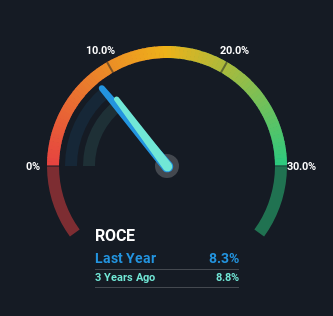- Hong Kong
- /
- Consumer Durables
- /
- SEHK:927
Fujikon Industrial Holdings' (HKG:927) Returns On Capital Not Reflecting Well On The Business

Ignoring the stock price of a company, what are the underlying trends that tell us a business is past the growth phase? A business that's potentially in decline often shows two trends, a return on capital employed (ROCE) that's declining, and a base of capital employed that's also declining. This combination can tell you that not only is the company investing less, it's earning less on what it does invest. On that note, looking into Fujikon Industrial Holdings (HKG:927), we weren't too upbeat about how things were going.
Understanding Return On Capital Employed (ROCE)
Just to clarify if you're unsure, ROCE is a metric for evaluating how much pre-tax income (in percentage terms) a company earns on the capital invested in its business. To calculate this metric for Fujikon Industrial Holdings, this is the formula:
Return on Capital Employed = Earnings Before Interest and Tax (EBIT) ÷ (Total Assets - Current Liabilities)
0.083 = HK$57m ÷ (HK$900m - HK$220m) (Based on the trailing twelve months to March 2023).
Therefore, Fujikon Industrial Holdings has an ROCE of 8.3%. On its own, that's a low figure but it's around the 9.5% average generated by the Consumer Durables industry.
See our latest analysis for Fujikon Industrial Holdings

Historical performance is a great place to start when researching a stock so above you can see the gauge for Fujikon Industrial Holdings' ROCE against it's prior returns. If you want to delve into the historical earnings, revenue and cash flow of Fujikon Industrial Holdings, check out these free graphs here.
What The Trend Of ROCE Can Tell Us
We are a bit worried about the trend of returns on capital at Fujikon Industrial Holdings. To be more specific, the ROCE was 11% five years ago, but since then it has dropped noticeably. On top of that, it's worth noting that the amount of capital employed within the business has remained relatively steady. This combination can be indicative of a mature business that still has areas to deploy capital, but the returns received aren't as high due potentially to new competition or smaller margins. If these trends continue, we wouldn't expect Fujikon Industrial Holdings to turn into a multi-bagger.
What We Can Learn From Fujikon Industrial Holdings' ROCE
In the end, the trend of lower returns on the same amount of capital isn't typically an indication that we're looking at a growth stock. Long term shareholders who've owned the stock over the last five years have experienced a 11% depreciation in their investment, so it appears the market might not like these trends either. Unless there is a shift to a more positive trajectory in these metrics, we would look elsewhere.
Fujikon Industrial Holdings does come with some risks though, we found 3 warning signs in our investment analysis, and 1 of those can't be ignored...
While Fujikon Industrial Holdings isn't earning the highest return, check out this free list of companies that are earning high returns on equity with solid balance sheets.
New: AI Stock Screener & Alerts
Our new AI Stock Screener scans the market every day to uncover opportunities.
• Dividend Powerhouses (3%+ Yield)
• Undervalued Small Caps with Insider Buying
• High growth Tech and AI Companies
Or build your own from over 50 metrics.
Have feedback on this article? Concerned about the content? Get in touch with us directly. Alternatively, email editorial-team (at) simplywallst.com.
This article by Simply Wall St is general in nature. We provide commentary based on historical data and analyst forecasts only using an unbiased methodology and our articles are not intended to be financial advice. It does not constitute a recommendation to buy or sell any stock, and does not take account of your objectives, or your financial situation. We aim to bring you long-term focused analysis driven by fundamental data. Note that our analysis may not factor in the latest price-sensitive company announcements or qualitative material. Simply Wall St has no position in any stocks mentioned.
About SEHK:927
Fujikon Industrial Holdings
An investment holding company, designs, manufactures, markets, and trades in electro-acoustic, accessories, and other electronic products in Hong Kong and Mainland China.
Flawless balance sheet low.
Market Insights
Community Narratives



